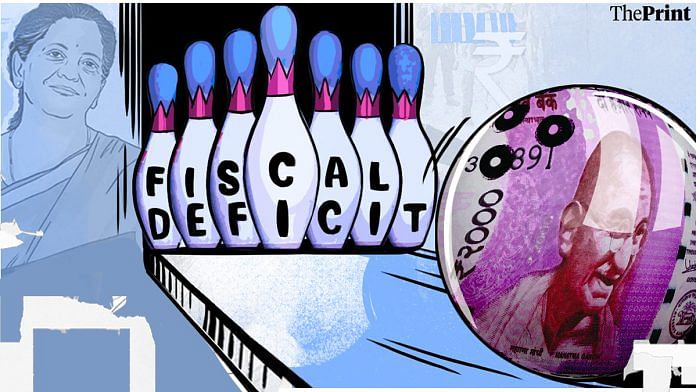New Delhi: The central government has displayed impressive fiscal discipline while formulating its announcements in Interim Budget 2024, according to economists. In doing so, it has prioritised fiscal consolidation over populism ahead of the general elections, they added.
Presenting her sixth consecutive budget — equalling the record set by Morarji Desai — finance minister Nirmala Sitharaman said that her interim budget would contain no tax cuts and that the government had set an ambitious fiscal deficit target of 5.1 percent of GDP for the financial year 2024-25.
The fiscal deficit for the current fiscal is estimated at 5.8 percent — marginally lower than the 5.9 percent target for the year.
“The hallmark of this interim budget is its fiscal rectitude,” said V.K. Vijayakumar, chief investment strategist at Geojit Financial Services following the budget speech. “The fact that the government has prioritised fiscal consolidation over populism on the eve of general elections is commendable.”
He added that the government’s push for the housing sector is another important element of the Budget as it would benefit ancillary industries like cement, steel, and other construction-related segments.
Aditi Nayar, chief economist and head of research and outreach at ICRA, said that the numbers presented in the interim budget were a positive indication of the quality of expenditure that will be done by the government.
“The higher than expected capex and lower than projected fiscal deficit suggest that the quality of expenditure is going to be healthier than what we had pencilled in both in FY2024 and FY2025,” Nayar said.
Apart from this, Ranen Banerjee, Partner and Leader, economic advisory, PwC India, said that pegging the fiscal deficit at 5.1 percent — which would mean the Centre would have to borrow less to finance the deficit — would free up space for the private sector to borrow more.
“The government has walked the path of fiscal prudence, and it is heartening to note that the fiscal deficit target for FY24, pegged at 5.8 percent, will be overachieved,” Banerjee said.
“The fiscal deficit being pegged at 5.1 percent for FY25 is a positive move as it will help free up space for private borrowings as they pick pace during the year, besides helping in containing inflationary pressures and supporting the bond markets,” he added.
Another broad theme of the interim budget 2024 is that it sought to rebalance the ongoing economic growth in favour of the rural economy, at a time when it was mainly concentrated among the more affluent strata of the economy.
“Two broad themes of this budget are fiscal consolidation and stepping up focus on agriculture/rural to course correct to some extent the differential benefit of the ongoing economic growth, which is tilted in favour of households of upper-income bracket/urban areas,” said Devendra Kumar Pant, chief economist and senior director of public finance at India Ratings and Research.
Pant added that the nominal GDP growth assumption and revenue buoyancy appeared plausible and in line with India Ratings and Research’s expectations.
At Rs 10.4 lakh crore, the budget documents show that the government expects corporate tax revenue to increase 13 percent in 2024-25 compared with the revised estimates of 2023-24 — Rs 9.2 lakh crore — and 17.2 percent compared to the budget estimates for that year.
This is compared with a 14.2 percent increase in corporate tax revenue seen last year.
Income tax revenue is expected to increase 13.1 percent to Rs 11.6 lakh crore in FY25 compared to the RE of FY24 (Rs 10.2 lakh crore), and increase 28.4 percent compared to what was budgeted last year.
Also Read: Cervical cancer vaccination for girls aged 9-14 stands out in lacklustre health budget
No tax rate reductions
Sitharaman said that there will be no change in the taxation regime, in keeping with the convention of no major announcements in interim budgets.
She said that, over the past 10 years, direct tax collections have increased threefold and the number of tax return filers, too, saw a 2.4-times increase.
Focusing on the new tax regime introduced during the Budget for FY 2023-24, Sitharaman said that the system had meant those opting for it would see no tax obligations for income up to Rs 7 lakh per annum.
Talking about indirect taxes, the finance minister said that the tax base of Goods and Services Tax (GST) has increased by more than two-fold and the average monthly gross GST collection has almost doubled to Rs 1.66 lakh crore this year.
She added that there was a positive sentiment in the minds of industry leaders towards GST. “According to a recent survey conducted by a leading consulting firm, 94 percent of industry leaders view the transition to GST as largely positive,” Sitharaman said in her speech.
“According to 80 percent of the respondents, it has led to supply chain optimisation, as elimination of tax arbitrage and octroi has resulted in disbanding of check posts at state and city boundaries.”
During her closing notes on taxation, Sitharaman proposed to withdraw disputed direct tax demands. She proposed to withdraw outstanding direct tax demands of up to Rs 25,000 pertaining up to FY 2009-2010 and up to Rs 10,000 for FY 2010-11 to 2014-15.
(Edited by Richa Mishra)
Also Read: RBI restricts Paytm Payments Bank services due to ‘non-compliances and supervisory concerns’



